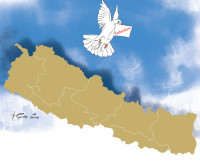Opinion
A remarkable feat
Nepal has set an extraoedinary example by achieving five years of Zero Poaching of rhinos between 2011 and 2018
As you are reading this piece, Nepal along with other global leaders are taking a pledge and discussing ways to eradicate illegal wildlife trade to protect the world’s iconic species from the threat of extinction at the London Conference. It is hoped that this two-day conference between 11th and 12th October will foster international cooperation to secure the future of our wildlife.
When it comes to protecting iconic species, Nepal has set a remarkable example to the world by achieving five years of Zero poaching of rhinos between 2011 and 2018, each Zero poaching year defined as 365 consecutive days without incident. Nepal’s dream of Zero poaching success has been realised by forging sustainable partnerships through a multi-agency approach that includes coordinated response from the highest levels of government to the grassroots of local communities, heightened protection measures in protected areas, buffer zones and community forests, and the use of innovative anti-poaching technologies.
The Himalayan nation’s zero poaching framework model has set an example for several Asian and African countries, including Bhutan, Kenya, Botswana, Tanzania, and Uganda. In February 2015, Nepal hosted Asia’s first Symposium on Zero poaching, where it showcased its model of rhino protection and where representatives of various conservation agencies, police, and prosecution services from across 13 Asian countries also shared their anti-poaching best practices, tools, and technologies. The framework for Zero poaching was endorsed at this symposium, including the Zero Poaching Toolkit that the conservation fraternity around the world has been using.
Being one of the most prized and targeted species in the illegal wildlife trade, countries have struggled to keep rhinos safe from highly-motivated poachers. After years of losing rhinos to poachers, Nepal celebrated cautiously when it achieved its first Zero poaching year in 2011-12. Subsequently, the country successfully achieved Zero Poaching of Rhino four more times, a phenomenal record. The Government of Nepal has shown exemplary commitment in putting together appropriate measures and constant monitoring security procedures. The two pillars of its conservation policy consisted of deploying the Nepal Army for protection of Protected Areas and implementing the concept of buffer zones, both of which laid the foundation for securing large expanses for free wildlife movement. More recently, the formation of Community Based Anti-Poaching Units have been successful in aiding law enforcement agencies in safeguarding rhinos and their habitats.
The control of illegal trade in wildlife is an important facet of the fight against wildlife crime. Multiple stakeholders, such as the Nepal Police and its Armed Police Force, have played a crucial role in controlling domestic and trans-boundary illegal trade of wildlife products. Loopholes are identified and plugged through an effective information sharing system between various law enforcement agencies, while the Wildlife Crime Control Bureau cells set up at trade hotspots to assess security measures and evaluate illegal linkages.
Despite successes in investigation and enforcement, poaching can often go undetected without a well-established wildlife monitoring program. To address this, the government has established a flagship program to create and maintain individual ID-based profiles of the estimated 645 rhinos in Nepal. This will help monitor the rhinos in their habitats and will also provide rhino location information to the protection authorities. Coupled with real-time SMART patrolling, a GPS-enabled patrolling tool, the IDs will help authorities keep a track of every rhino in Nepal. This marriage of the zero-poaching framework and long-term ecological monitoring, in effect, has facilitated the achievement and maintenance of zero poaching of rhinos over the years.
For Nepal, keeping the Zero poaching legacy alive is a challenge as well as an opportunity. As poaching remains a continuing threat, addressing it needs real-time solutions for prompt anti-poaching responses. The Government on Nepal’s key ongoing strategic partnerships for combating wildlife crime, in addition to youth mobilisation, introduction of innovative technologies, regular monitoring, habitat improvement, and development of Conservation Action Plans, has together resulted in the country’s enviable Zero Poaching feat. The Government of Nepal will continue to need support from its many partners in the coming years to sustain its conservation accomplishments.
Global conservation organisations like WWF have been supporting rhino conservation across the region, including in Nepal. In the last 50 years, WWF Nepal along with other conservation partners and supporters such as USAID, KFW, the World Bank, National Trust for Nature Conservation, and Zoological Society of London (ZSL), among others, have been implementing strategic rhino conservation initiatives in collaboration with the Government of Nepal. USAID’s Hariyo Ban Program and other partner initiatives have been instrumental in scaling up Community Based Anti-Poaching Units, developing landscape strategies and action plans, creating market-based livelihood initiatives, supporting wildlife censuses and studies, managing human-wildlife conflict and habitat management issues, creating awareness, and building capacity of local conservation stakeholders.
Nepal awaits a fresh estimate of its rhino population, with the next count scheduled to be held in early 2019. Prior to the 1960’s, over 800 rhinos were estimated to be living in Nepal. Given the recent strides made in rhino conservation, the nation’s goal to bring back rhino numbers to that historic number is within reach.
- Thapa is the Technical Advisor-Biodiversity Conservation for USAID’s Hariyo Ban Program and Wildlife Lead at WWF Nepal.




 15.12°C Kathmandu
15.12°C Kathmandu.jpg&w=200&height=120)







%20(1).jpg&w=300&height=200)

